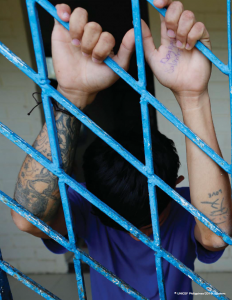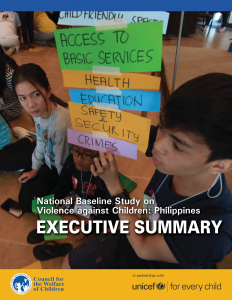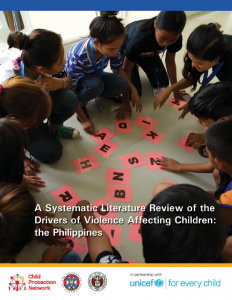 This study was a nation-wide research using quantitative and qualitative designs that aimed to gather national epidemiological data on violence against children experienced in a range of situations and locations. It also included a stakeholders’ qualitative analysis that sought to identify the factors that facilitate or impede a more effective implementation of VAC programs in the local level and under a devolved setting. Specifically, it sought to:
This study was a nation-wide research using quantitative and qualitative designs that aimed to gather national epidemiological data on violence against children experienced in a range of situations and locations. It also included a stakeholders’ qualitative analysis that sought to identify the factors that facilitate or impede a more effective implementation of VAC programs in the local level and under a devolved setting. Specifically, it sought to:
- Estimate the national prevalence of violence against children (VAC) in various forms and settings;
- Enumerate the social and health consequences of VAC;
- Assess children’s awareness and utilization of health, legal and welfare services related to VAC;
- Obtain stakeholders’ views about VAC including the perceived reasons why VAC persist in the communities, adequacy/inadequacy of existing services, type of resources and services still needed, their readiness to implement VAC services` as well as their capacity-building needs.
This study is the first ever national study on violence against children in the Philippines. The results can be used as scientific benchmarks in developing proactive interventions to prevent violence against children, and to help child-victims overcome their very difficult experiences.
 The prevalence survey was conducted in 172 randomly selected barangays (villages) in the 17 regions of the country. In each barangay, 25 households were systematically sampled, and in each household, one eligible child was selected as the final respondent using the KISH method.[1] Different sets of barangays were assigned to males and females.
The prevalence survey was conducted in 172 randomly selected barangays (villages) in the 17 regions of the country. In each barangay, 25 households were systematically sampled, and in each household, one eligible child was selected as the final respondent using the KISH method.[1] Different sets of barangays were assigned to males and females.
Three thousand and eight hundred and sixty-six (3,866) children participated in the study, giving an overall response rate of 89.85 percent (males=90.7%; females=89.0%). Data-collection was mostly self-administered. Ethical considerations were prioritized through the research design and methods, the appropriate training of field interviewers, and the use of a response protocol.
The initial results were peer reviewed by six subject matter experts. This included three Filipino academics; experts on epidemiological methods and on child protection. International experts on VAC also reviewed the results, including those who have provided extensive technical support and guidance to other similar VAC surveys, including in Asia. The final statistics, discussions, and recommendations incorporated the results of the peer review and the NBS VAC Steering Committee’ comments and inputs.
Note:
[1] A procedure for objective respondent selection within the household. It uses a pre-assigned table of random numbers to find the person to be interviewed.
 Executive summary
Executive summary
National Baseline study on Violence against Children: Philippines
 Long technical report
Long technical report
A Systematic Literature Review of the Drivers of Violence Affecting Children: the Philippines
Journal articles

